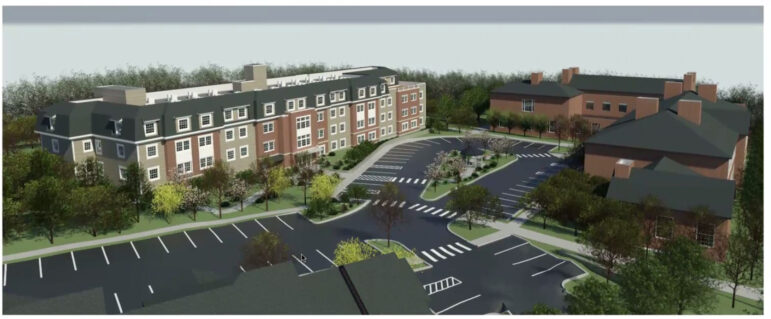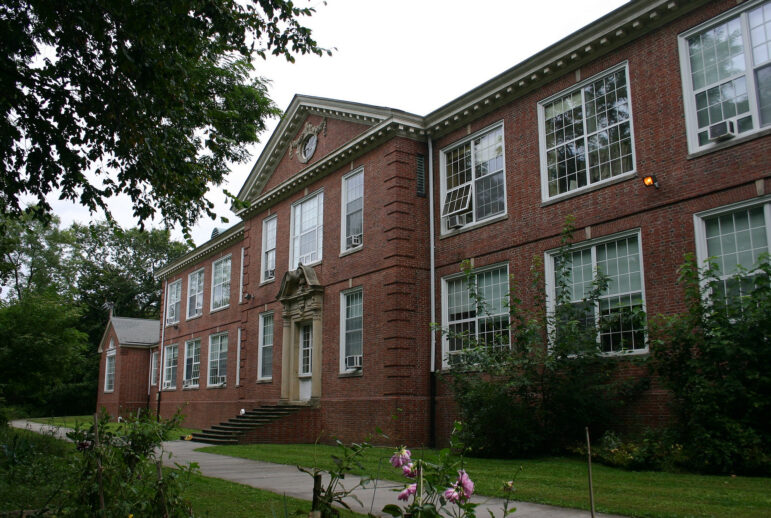On Thursday night, during his radio show, Sam Romeo, who is the chair of the board of the housing authority, now called Greenwich Communities, made an announcement.
He said his application for Vinci Gardens, despite having been approved by Greenwich Planning & Zoning Commission, would be resubmitted under the state affordable housing statute, 8-30g.
His explanation was that that the conditions of the Sept 8 approval were unreasonable.
The vote was 5-0 in favor of the 50,000 sq ft development in Byram featuring 52 units of affordable housing for seniors.
“To make me make something new and clean in the 21st century to look like something that is old and decrepit, you’re going to have a long wait.”
– Sam Romeo, chair of Greenwich Communities (formerly the Housing Authority of the Town of Greenwich)
The P&Z decision came after months of wrangling over details of the bulky, modular construction, four-story building during both Architectural Review Committee and P&Z meetings.
At an early August P&Z meeting, Greenwich Communities director Tony Johnson said between $150,000 and $200,000 had already been spent on fees for attorneys, architects and engineers.
At that meeting he told the commission to “either vote it up or down.”
Mr. Romeo was firm. “We’re not going to make any more changes.”
Attorney Chris Bristol reminded the commission that all the units in Vinci Gardens would count toward the State of Connecticut’s 8-30g requirements.

The development was not submitted to Greenwich P&Z as an 8-30g.
Instead, as with all the housing authority’s past projects, the application was submitted under local zoning regulations.
In addition to Site Plan and Special Permit, Vinci Gardens required a variance for setback, and both a Municipal Approval (MI) and rezone from R6 to Elderly. All were approved by P&Z.

The Fight for Local Control
Mr. Romeo has been a vocal opponent of Connecticut’s 8-30g statute.
The statute requires all 169 municipalities to have at least 10% of their housing stock designated affordable per a state formula.
For years Greenwich’s percentage of affordable housing has hovered around 5%.
Until the town achieves 10% or earns a moratorium, the 8-30g statute applies, and developers can propose buildings without complying with local zoning, except in rare instances of health and safety.
Mr. Romeo testified against additional affordable housing legislation at hearings in Hartford, including a Jan 2021 Zoom panel discussion on Transit Oriented Development around train and bus stations. He said developers “have a different mind set” and use 8-30g to try to maximize every square foot of a property and make the most profit.
Mr. Romeo also testified at Greenwich P&Z hearings, saying 8-30g was flawed and in need of revision, and that developers were abusing the statute.
In January 2022, Romeo testified against a 5-story 85-unit apartment building at 5 Brookridge submitted under 8-30g, describing it as “another offspring of the Hyde Hotel.”
At a hearing on a proposed 190-unit 7-story development on Church Street to replace a row of historic houses in the Fourth Ward, Romeo referred to 8-30g as the Cinderella Statute.
“The step sisters try to get their foot into that tiny glass slipper and make it fit at any cost,” he said.
Greenwich Communities
To be fair, Greenwich Communities does not operate on a for-profit basis.
Unlike a private developer, every unit the housing authority creates is affordable and moves the needle closer to Greenwich’s 10% goal.
Vinci Gardens
Mr. Romeo suggested the P&Z decision on Vinci Gardens would financially burden the housing authority, that the conditions imposed were overreach, and that it would result in the reduction of 17 units.
During the Sept 8 meeting, commissioners Peter Levy and Nick Macri said they felt strongly about mansard roofline and vinyl siding.
Though P&Z chair Margarita Alban reminded the commission of the importance of making the building “deeply affordable,” and P&Z director Katie DeLuca cautioned that changing the roofline might have zoning implications – “…they may not be able to do that and get the number of units they want.” – the commission voted to approve with conditions, including:
• that the applicant work with P&Z staff on the change from vinyl siding to brick veneer and the revised roofline from mansard to hip or gable geometry in keeping with that it is a National Historic Register site.
• that the applicant submit a draft affordability plan to P&Z staff and law department for review.
• that prior to the C/O the applicant shall submit an affordability plan to the P&Z staff and law department.
After the meeting Mr. Romeo said in an email that the commission’s conditions were “arbitrary,” and difficult to reconcile with approval of a large, luxury senior independent living facility on Old Track Road.
Resubmitting Vinci Gardens an 8-30g
During his Sept 22 radio show Mr. Romeo explained the decision to resubmit the Vinci Gardens application to P&Z as an 8-30g.
“We went by the book and we didn’t use the state statute 8-30g,” Romeo said. “The Planning & Zoning commissioners would like to redesign what we submitted. I think that’s well beyond their purview…their job is to see that it meets the current zoning regulations.”
Romeo voiced particular criticism of the requirement that the look of the new building compliment the former Byram School building, which is on the National Register of Historic Places.
“That’s not going to happen, I can tell you right now, folks,” Romeo said live on the radio. “P&Z if you’re listening, it’s not going to happen. I’m going to re-file. Expect it.”
“I’m going to do something I never wanted to do. I’m going to refile this application and challenge your decision with an 8-30g. The only thing you can look at is health and safety. There is no health and safety issue here. I will build what we’re going to build.”
“Their job is to approve something or disapprove something, not to redesign it. I didn’t hire them as architects. I don’t care what their likes or dislikes are.”
“And I will not lose 17 units of senior housing because somebody wants it to look like Byram School,” Romeo continued. “If I had my druthers I would demolish Byram School and rebuild it.”
Mr. Romeo said the former Byram School, which is now affordable housing run by Greenwich Communities, uses electric heat, which is expensive. He also complained that the large windows the town required match the original school windows were not energy efficient.
“There’s no real significance of architectural there,” Romeo said. “I’d put something in there more modern, and more conducive, and more energy efficient than that building.”
“To make me make something new and clean in the 21st century to look like something that is old and decrepit, you’re going to have a long wait,” Romeo said.
See also:
Greenwich Communities Unhappy with Conditions of P&Z Approval for Vinci Gardens
Sept 13, 2022
Greenwich Housing Authority Frustrated over High Cost of P&Z Process for Vinci Gardens
August 6, 2022
Proposed “Vinci Gardens” Criticized for Height, Mass, Tree Loss, Lack of Respect for Historic Byram School June 10, 2022
P&Z WATCH: Tough Questions Posed for Greenwich Housing Authority’s 52-Unit “Vinci Gardens” Sept 29, 2021
P&Z Watch: Pre-Application Submitted for “Vinci Gardens,” 52 Elderly Apartments in 4 Story, 50,000 sq ft Building in Byram August 6, 2021
